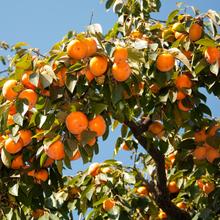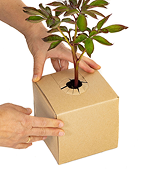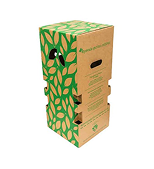- Home
- Exoticflora Favourite's
- Persimmon Fruit Plant
Persimmon Fruit Plant





Persimmon Fruit Plant




Damaged or lifeless? We’ll replace it for free. Learn more

Double layered custom boxes to protect plants during shipping.

Air vents for proper air-flow

To preserve plant freshness during transit

Details steps of how to grow and maintain your plant
Botanically known as Diospyros kaki, the Persimmon Fruit Plant is a deciduous tree prized for its delicious, sweet-tasting fruit. Originating from East Asia, particularly China and Japan, this fruit-bearing tree is cultivated for its vibrant orange to red-orange fruits, which ripen in the late fall to early winter months. The Persimmon tree typically grows to a height of 15 to 30 feet, with glossy, dark green foliage that turns vibrant shades of yellow, orange, and red in the autumn, creating a stunning display.
The Persimmon fruit is renowned for its unique flavor profile, which ranges from sweet and honey-like when ripe to astringent and slightly bitter when unripe. When fully mature, Persimmons are soft, succulent, and bursting with sweet juices, making them a popular choice for fresh consumption, baking, and culinary preparations. Beyond their delightful taste, Persimmons offer a plethora of health benefits when included in a balanced diet.
Growing Tips
- Persimmon trees thrive in well-drained, loamy soil with a slightly acidic to neutral pH level (pH 6.0 to 7.5).
- Provide full sunlight exposure for at least 6-8 hours daily to ensure optimal growth and fruit production.
- These trees prefer temperate to subtropical climates with moderate rainfall and mild winters. Protect them from frost and extreme cold.
- Regular watering is essential, especially during dry periods and hot weather. However, avoid overwatering, as Persimmons are sensitive to waterlogged conditions.
- Pruning should be done during the dormant season to shape the tree, remove dead or diseased branches, and improve air circulation.
- Apply organic fertilizer high in nitrogen, phosphorus, and potassium annually in the spring to promote healthy growth and fruit development.
Inside the Box
- Persimmon Fruit Plant: Approximately 1-2 Feet Height
- Growing Pot (Terracotta color): 8 Inch (Note: The above specifications are indicative; actual dimensions may slightly vary.)
Fruition Time: After 1 year.
Initial Care for 10-15 Days Just After Receiving Your Plant
- Carefully unpack the plant, ensuring no damage occurs to the leaves or roots.
- Firmly press the soil in the pot and top up with additional soil if necessary to ensure stability.
- Keep the soil consistently moist but not waterlogged. Allow the top inch of soil to dry out between watering sessions.
- Place the plant in a location with ample morning sunlight exposure for 2-3 hours daily during the initial 10-15 days. Avoid immediate transplanting.
- After one month, consider transplanting the plant into a slightly larger pot or directly into the ground, if desired.
- Prune any damaged or dead branches to encourage new growth and maintain plant health.
Selected plant of 8-10 inches
Planted into a 5-inch pot
With healthy, moisture-retaining soil
A care instruction sheet for maintenance guide

Get in touch for best pricing on bulk orders and landscaping projects.
 WhatsApp us
WhatsApp us

Call on 9177805454 (Mon-Sat, 9 AM-6 PM) or WhatsApp us – we’re here to help.
About Exotic Flora
At Exotic Flora, we’re passionate about bridging the gap in bringing plants to everyone. With over 500+ varieties across 7 plant categories, from exotic finds to everyday greens, we bring the entire range to you.
Our plants, sourced from all parts of India are nurtured at Kadiyam, in our 25 acres in-house nursery by a team of expert horticulturists. Once they are ready we ship all our plant varieties across India.
Our services go beyond safe delivery of plants. A dedicated support team is there to help you with any maintenance queries you may have.
At Exotic Flora we always believe in going that extra mile, because everyone should have the plants they love.